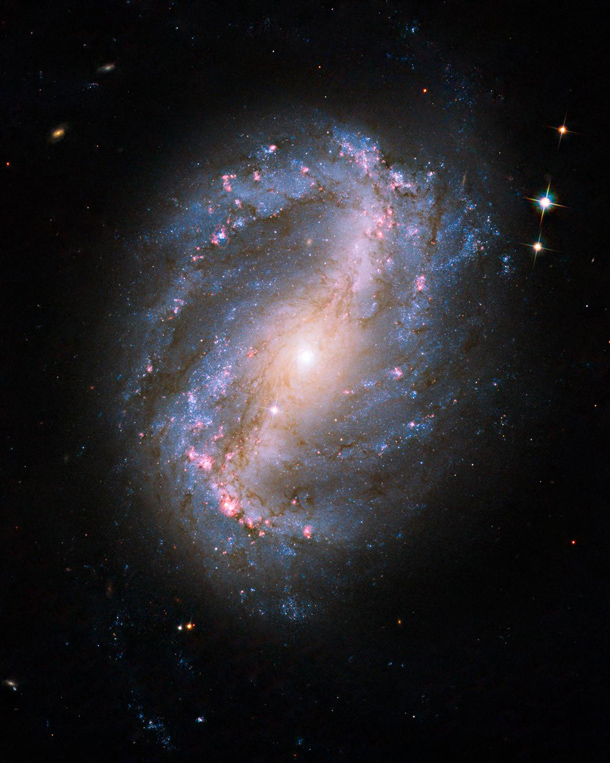but what's a week compared to 80,000,000 years?
NASA's newly-repaired Hubble Space Telescope snapped this panoramic view of a colourful assortment of 100,000 stars residing in the core of the giant star cluster, Omega Centauri.
And who cares if I'm off topic.* This is awesome.

Inside a globular star cluster
The image reveals a small region inside this massive globular cluster, a giant ball of millions of stars that orbits the Milky Way. All the dots are stars in the cluster, which orbits our galaxy. Omega Centuri boasts nearly 10 million stars, between 10 billion and 12 billion years old.
This image alone shows about 100,000 stars at all stages of evolution, from slowly glowing yellow to furiously churning red — stars at the ends of their lives, about to burn out out into tiny, hot white dwarfs (= the faint blue dots in the image). White dwarfs no longer generate energy and have gravitationally contracted to the size of Earth. Tiny, as they say. These will continue to cool and grow dimmer for many billions of years until they become dark cinders. The snap also shows sapphire blue stars, helium-rich objects also nearing cosmic senescence but having picked up a new lease on life when they collided and merged with other stars. Those encounters boost the stars' energy-production rate, making them appear bluer. All of these are phases of evolution that many stars eventually go through.
If anyone lived in Omega Centauri (which we should be thankful they don't), they would behold a star-saturated sky that is roughly 100 times brighter than Earth's sky. From our vantage point, on the other hand, this is one of the few clusters that can be seen even with the unaided eye -- the 24th brightest object in the constellation Centaurus, resembling a small cloud in the southern sky that might easily be mistaken for a comet.
Hubble's new view of a spiral galaxy in living colour

This is NGC 6217, a relatively close spiral galaxy (at a distance of roughly 80 million light years) in the north circumpolar constellation Ursa Major. You can easily spot huge numbers of glowing pink star-forming areas, where stars are being born in prodigious quantities. And even from this vast distance — 800 quintillion kilometres (500 quintillion miles) — Hubble can still pick out individual stars in the spiral arms. The brightest ones are the stars that will someday explode as monstrous supernovae.
Actually, since the light is 80 million years old, perhaps most of the big visible stars have already exploded and the light just hasn’t made it to Hubble yet.
To put this in a little perspective, you can see some other galaxies waaaay off in the distance behind NGC 6217.
Just a tiny Hubble piece of the universe, really.
Scientists seem to like to use the word Awesome. Zenobia can understand why.
*Next week I promise to get back on topic with the historical Zenobia in some guise or other. But 2,000 years ago suddenly seems such a piddling time scale. I'll have to get used to it again.
My thanks to Julianne at Cosmic Variance for awesome reporting and to Phil Plait at Bad Astronomy for much-needed background; and additional thanks to some of those who commented on both blogs.
Illustrations
Above: Omega Centauri from NASA.gov. Credit: NASA, ESA, and the Hubble SM4 ERO Team
Below: NGC 6217 from NASA.gov. Credit: NASA, ESA, and the Hubble SM4 ERO Team
But 2,000 years ago suddenly seems such a piddling time scale. I'll have to get used to it again.
ReplyDeleteAin't that the truth? A little time with the telescope always makes me feel much closer to otherwise remote historical settings.
Hello,
ReplyDeleteBravo, this excellent phrase is necessary just by the way
Sweet site, I hadn't noticed www.blogger.com before in my
searches!
I invte you to my homepage, hew down unmindful of to watch over my blogrbpl [url=http://www.radiobielsko.pl]nieruchomosci bielsko[/url]
Hello,
ReplyDeleteIn it something is. I will know, I thank for the information.
Sweet site, I hadn't noticed www.blogger.com before in my
searches!
I invte you to my homepage, mean-spirited to of indentation manumitted to confine my blogrbpl [url=http://www.4labels.pl]etykiety foliowe[/url]
Really worthwhile data, much thanks for the post.
ReplyDelete